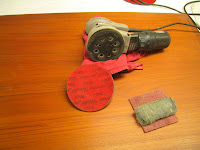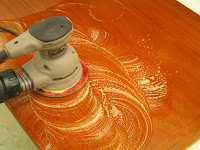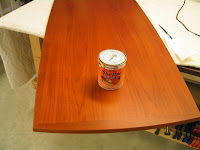 Working on refinishing a teak/veneer coffee table that a friend purchase many years ago in the discount section. I suspected the veneer just de-laminated. However working on the table it was apparent while heating (after stripping the finish off cover the spot with thin cardboard and use medium heat from a household iron to warm the spot, this sometimes reactivates the glue) it wouldn't stick down. So I took a razor blade and slit into 2 of the bubbles and hit it with more heat then while pressing with my finger I could definitely feel something firm. Obviously, some crud must of been trapped underneath the veneer from the factory. The dents and deep scratches have been removed with a hot steam iron along with the alcohol water trick. I think our friends are going to be very surprised. Because of the thin veneer, I didn't want to take a chance of sanding through with my random orbit sander ("ROS") so I block sanded with 220 by hand instead.
Working on refinishing a teak/veneer coffee table that a friend purchase many years ago in the discount section. I suspected the veneer just de-laminated. However working on the table it was apparent while heating (after stripping the finish off cover the spot with thin cardboard and use medium heat from a household iron to warm the spot, this sometimes reactivates the glue) it wouldn't stick down. So I took a razor blade and slit into 2 of the bubbles and hit it with more heat then while pressing with my finger I could definitely feel something firm. Obviously, some crud must of been trapped underneath the veneer from the factory. The dents and deep scratches have been removed with a hot steam iron along with the alcohol water trick. I think our friends are going to be very surprised. Because of the thin veneer, I didn't want to take a chance of sanding through with my random orbit sander ("ROS") so I block sanded with 220 by hand instead.Last week, one day our weather hit in the 60's (did you know... shellac isn't temperature sensitive and cold weather even under 40 won't affect the cure, that's a good thing to know way up here in the cold North), so I set up the garage to spray. I used the Zinsser Bulls Eye Amber Shellac 3 pound cut straight from the can (don't forget to strain your shellac it does contain lots of junk,chunks even bug parts) and put down a heavy coat or two. Sanded back with 320, then I decided to have some fun and hooked on to my ROS the Mirka Abralon 1000 and 2000 grit sanding pads to figure out my sheen. Wet the table top with soapy water and WOO HOO. No I didn't electrocute myself, but don't you do that, water and electricity DON'T MIX. Do not use an electric sander for this operation.
 I want to achieve a satin finish and get that "close to the wood" feel as possible. I didn't really pile on that much shellac. Just enough to rub. So first, it's necessary to remove the gloss from the grain pockets to match the satin sheen of the higher top surface. To do this, I used 00 steel wool (didn't have any 0000 steel wool) and scrubbed (not hard) in the direction of the grain, then went over the entire top with maroon scuff pad.
I want to achieve a satin finish and get that "close to the wood" feel as possible. I didn't really pile on that much shellac. Just enough to rub. So first, it's necessary to remove the gloss from the grain pockets to match the satin sheen of the higher top surface. To do this, I used 00 steel wool (didn't have any 0000 steel wool) and scrubbed (not hard) in the direction of the grain, then went over the entire top with maroon scuff pad. Using the 1000 grit Abralon pad will give you approximately satin sheen. Using soapy water as a lubricant, hit it ACE! I Keep the ROS (sander) moving using light pressure (the weight of the sander is all that is necessary)
Using the 1000 grit Abralon pad will give you approximately satin sheen. Using soapy water as a lubricant, hit it ACE! I Keep the ROS (sander) moving using light pressure (the weight of the sander is all that is necessary)
 All done! It's that simple and looks great as is. But! I went ahead and put a coat of wax on to shine things up just a wee little bit....It's so easy guys and gals...you just can't mess up with the Abralon pads. Try them they work great, just as easy using by hand.
All done! It's that simple and looks great as is. But! I went ahead and put a coat of wax on to shine things up just a wee little bit....It's so easy guys and gals...you just can't mess up with the Abralon pads. Try them they work great, just as easy using by hand.


